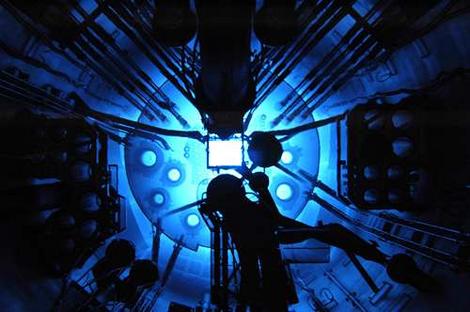A nuclear reactor is an installation capable of initiating, controlling and maintaining nuclear reactions (fission usually) chain occurring in the core of the facility.
The composition of the nuclear reactor is formed by the fuel, coolant, control elements, structural materials and, in the event that it is a thermal nuclear reactor, the moderator.
Nuclear reactors can be classified as rapid thermal reactors and reactors.
Thermal reactors are those which function by delaying (moderating) the faster neutrons or increasing the proportion of fissile atoms. To slow the neutrons, called slow neutrons, a moderator is required which can be light water, heavy water or graphite.
Fast reactors are not required to moderate the speed of electrons and using fast neutrons.
To build a nuclear reactor is necessary to have enough fuel, we call critical mass. Having enough critical mass means having enough fissile material in good condition to maintain a chain reaction.
The provision of neutron absorbers and control rods to control the chain reaction and stopping and starting of the nuclear reactor.
In the reactor core occurs and manteiene the nuclear chain reaction in order to heat the water to be used for driving the turbine of the plant.
Components nuclear reactor core
A nuclear reactor consists of the following components:
Nuclear Fuel

Nuclear fuel is a material capable of fission enough to reach critical mass, that is, to maintain a nuclear chain reaction. Is positioned so that it can quickly remove the heat produced by this nuclear reaction chains.
In nuclear power plants using solid fuel. The nuclear fuels vary depending on the type of reactor used but generally
uranium derivatives.
In general, a fuel element is constituted by a quadrangular arrangement of fuel rods, as seen in the image. While Russian nuclear reactor VVER pressurized water is constituted by a hexagonal arrangement.
The guide tubes are attached to the fuel support grids in this way is able to maintain the centers of the fuel rods and tubes guíaa the same distance.
The mechanical design of the different fuel elements is identical. Some contain bundles and control rods containing burnable poisons or other neutron sources.
To ensure the quality of the fuel elements, there are numerous inspections and testing of both raw materials and the final product.
Control rods
The control rods beams provide a rapid means for controlling the nuclear reaction. Allow rapid changes reactor power and eventually stop in case of emergency. They are made of neutron absorbing material (boron carbide or alloys of silver, indium and cadmium, etc.) and typically have the same dimensions as the fuel elements. The reactivity of the core increases or decreases by raising or lowering control rod, that is, modifying the presence of neutron absorbing material contained in them in the nucleus.
For a reactor operated for a period of time must have an excess of reactivity which is maximal with fresh fuel and decreases over the life of the same until it is canceled, when the refill is made of fuel.
In normal operation, a nuclear reactor is the control rods fully or partially extracted from the nucleus, but the nuclear plant design is such that any fault in a security system or reactor control, always acts in the sense of security of introducing reactor completely all the control rods in the reactor core and carrying a safe stop in a few seconds.
Moderator
The resulting neutron fission reaction have high kinetic energy (high speed gain). The higher your speed is less likely to fisionen other atoms so that this speed should be reduced to encourage new chain reactions. This is achieved by elastic collisions of the neutrons with nuclei makes moderator element.
Among the most commonly used moderators are light water, heavy water and graphite.
Coolant
In order to use the heat energy given off by nuclear fission reactions using a refrigerant. The function of this heat refrigerant and transport aboserver. Coolant must be corrosion, with a large heat capacity and should not absorb neutrons.
The most common refrigerants are gases, such as carbon dioxide and helium, and liquid as the light water and heavy water. There are even some liquid organic compounds and metals such as sodium, also using for this function.
Reflector
In a nuclear chain reaction, a certain number of neutron tends to escape from the region in which it occurs. This neutron leakage can be minimized with the existence of a reflecting means to redirect them into the reaction region. In this manner serves to increase the efficiency of the reactor. The medium reflector surrounding the core must have a low capture cross section for not reducing the number of neutrons and to reflect as many of them.
The choice of material depends on the type of reactor. If we have a thermal reactor, the reflector can be the moderator, but if we have a fast reactor reflector material must have a large atomic mass to reflect neutrons in the nucleus with its original speed (inelastic scattering).
Shield
When the reactor is in operation, it generates large amounts of radiation. Protection is needed to isolate the installation workers caused by radiation from fission products.
Therefore, biological shielding is placed around the reactor to intercept these emissions.
The materials used to build this shield are concrete, water and lead.



